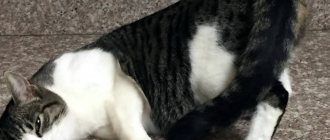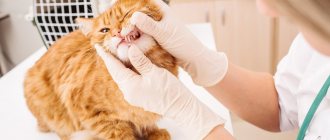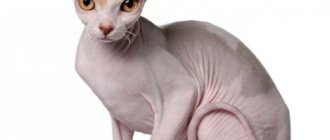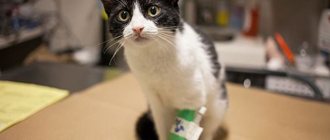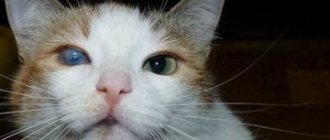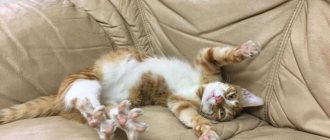How many whiskers do cats have?
Rarely does the average person think about how important the mustache is for his cat, which amusingly decorates the face of a meowing pet.
In fact, this is a very significant organ of smell, which represents receptors that have changed in the process of evolution. In the scientific world, a cat's whiskers are called whiskers, the most magnificent of which are located on the muzzle, and the rest can grow on the paws, tail or chin. There are a lot of interesting things associated with mustaches; we will look at some of the interesting information in this article. The average number of whiskers for felines is 24, which are evenly spaced near each side of the nose and grouped in four horizontal rows. In addition, vibrissae grow near the eyes, on the tip of the tail, between the toes and on the chin. People do not perceive these hair extensions as whiskers, although they similarly serve the function of measuring texture, objects, or boundaries.
Do cats lose their whiskers?
Cats' whiskers change constantly, as does molting. This is a completely normal phenomenon and should not cause concern. New hairs will definitely grow in place of the fallen hairs. A cause for concern will be too active loss of whiskers or their complete absence after molting. It is advisable to visit a veterinarian, as your pet may lack vitamins or be seriously ill. You need to understand that without whiskers, the animal loses its “navigation system” and becomes practically helpless. His condition can be compared to that of a man who has lost his glasses. A cat is quite capable of getting lost, injuring its eyes, getting stuck in a crevice, or falling into a sewer hatch. Therefore, if your pet’s whiskers have fallen out or broken off, and you are looking for information about whether cats grow whiskers, try not to let your pet out of the house until this type of feline whisker grows back completely.
How long is a cat's whiskers?
The average length of a cat's whiskers is about 6-7 centimeters, which depends on the breed, health and nutrition of the animal. However, there are cases where a cat had whiskers as long as 19 centimeters, and this is not considered an anomaly. There is an opinion that the most mustachioed cats are excellent rat catchers, perfectly aware of their hunt.
A very interesting fact is that mother cats constantly bite off the whiskers of their heirs. In this way, they force the offspring to stay close to her and not leave the lair. This is a kind of survival instinct that has preserved the feline appearance for many centuries.
Number of teeth
Cats' teeth grow a little faster than humans' teeth. For example, without teeth they live only 2-3 weeks after birth. If the incisors do not appear at this stage, this is already a reason for a visit to the veterinarian.
In kittens
Kittens first develop baby teeth. At this time, pets may bite, as the gums are very itchy. In addition, saliva begins to actively secrete. And although people usually do not pay attention to this, the kitten suffers in the same way as a human child.
Therefore, it is best for those who care for their cats to purchase a special pain reliever from a veterinary pharmacy. They need to smear the places where teeth appear. By the age of 3 months, kittens have 26 baby teeth, 14 of them are on the upper part of the jaw, and 12 on the lower.
In adult cats
After 120-160 days, baby teeth fall out and permanent teeth appear, in the same sequence as baby teeth. The process of jaw formation is completely completed by 8 months. An adult healthy cat should have 30 healthy teeth . If their number is less or more, this is already considered a deviation from the existing norm.
How many whiskers does a cat have?
Cats are quite graceful and perfect creatures. Is it possible to imagine the face of a homely beauty without funny and long mustaches, which not only decorate and give importance, but also perform a rather important function: they help to navigate in space. In science, whiskers are called vibrissae, from the word to vibrate. The cat, vibrating its antennae, learns about the object and surroundings. People living next to these charming creatures are well aware of the functions of their pets' whiskers, but few people have thought about how many whiskers a cat has.
Types of mustaches
In addition to the whiskers located on the cat's muzzle, there are other hairs that have a similar structure and function to those of regular whiskers, but are coarser than the animal's normal fur. These are hairs found on the cat's paw pads, above the pet's eyes, which look like eyebrows, under the chin, near the eyelids, and even on the tail. Of course, these hairs are less sensitive than the antennae located on the animal's face, but they are also important for hunting and orientation in space.
Where are they located?
One type of whiskers in cats is located on the sides of the nose above the pet’s upper lip, as children draw in pictures. It is these whiskers that are the longest and toughest; thanks to their sensitivity, they help the cat process a huge amount of information. Thickened hairs located on the cheeks, chin, and above the eyes are also vibrissae. Surprisingly, the compacted hairs located on the ankles of the paws and between the toes are also considered vibrissae.
How many whiskers does a cat have?
Normally, a cat has 24 antennae. They are arranged in four rows on each side. Moreover, the two upper rows of whiskers can move autonomously, regardless of the two lower rows of whiskers.
There are three vibrissae in each row, that is, there are 12 antennae on each side of the muzzle. In total, these cute creatures have 24 vibrissae, without which they could not even exist. This refers to the antennae growing on the upper lip, in zoology called the anus, which is adjacent to the nasal mirror. If you count the total number of antennae on a cat, then on the face, together with the vibrissae located on the whiskers, eyelids and chin, there are from 33 to 40 antennae.
What is the length
Typically, the length of a cat's whiskers varies from 5 to 7 centimeters. But there are also exceptions. For example, cats - representatives of the Maine Coon breed - have registered truly gigantic whiskers - 19 centimeters, and in the Cornish Rex and Sphynx breeds the whiskers are not only small in size, but they are also curled, thereby making the whiskers look even shorter than they actually are . There have been cases when sphinxes had no mustaches at all, and this did not in any way affect their ability to navigate in space.
There is a popular belief that in a cat the very tips of the splayed whiskers are equal to the width of the animal. This helps them navigate when passing through a narrow opening. Having fluffed its antennae, the cat knows in advance whether it will fit into a given hole or not. As soon as he touches the hole with the tips of his mustache, he has reliable information about whether he should stick his nose in there.
The distance between the tips of the whiskers in a cat corresponds to the width at the shoulders of this animal.
A cat's whiskers are not only an attribute of beauty, but also a rather important organ. An experienced owner will determine not only the physical, but also the psychological state of the pet based on the condition of the mustache. And, if at some point the number of antennae on a cat decreases, then this is not a problem, the main thing is that you need to pay attention to your pet. With the necessary care, the broken antennae will grow back and perform their function properly.
The True History of Brushing Cat Teeth
The author of these lines, while writing the article, also decided to look into the mouth of his cat, and this is what came out of it.
To begin with, the peacefully sleeping cat was awakened by demands to show his teeth.
I don't know about other pets, but ours will never do what we want. And now, apparently out of spite, he tightly closed his jaws no worse than a real bulldog and flatly refused to satisfy our curiosity. I had to resort to a “master key” in the form of a piece of sausage. While Barsik quickly chewed it, suffering from obsessive attention to his person, we tried to count his teeth. The sausage ran out before it was possible to do this.
So, the age of the cat could not be determined. But, looking into his mouth, I managed to notice that his fangs were not at all as white as I would like, and were covered with a yellow coating. The smell also left much to be desired. Considering that, in principle, the cat leads a healthy lifestyle and has no bad habits, this was strange. However, no one had ever brushed his teeth, but apparently they should have.
Often, in order to brush a cat’s teeth, you have to “persuad” him for a long time to open his mouth.
My daughter was perplexed as to why she needed to brush her cat’s teeth. I explained that yellow plaque can lead to tartar, which can lead to caries and even tooth loss. In addition, brushing your cat's teeth would eliminate the unpleasant odor from the cat's mouth.
One method of cleaning cat teeth found on the Internet was to rub the animal's teeth with red wine and soda.
Such a proposal was met with indignation by both the cat and the husband, from whom the thought of transferring a valuable product caused protest. I clarified that the wine needed was cheap, like vinegar. The husband unexpectedly objected that it was forbidden to rinse the cat’s mouth with anything (he managed to realize that it was unlikely that a whole bottle would be used for one cat, and therefore it could then be used for its intended purpose). This means that the wine must be worthy.
Barsik resolutely made it clear that he would not allow such dubious experiments to be carried out on himself. However, the husband no longer insisted on his participation in drinking good wine.
Another option for cleaning teeth was dry hard treats, the consumption of which gives the pet pleasure and removes plaque.
Alas, this method did not work for the cat either. No matter how we tempted him with chopsticks, no matter how we rolled our eyes, inhaling their wonderful aroma, no matter how we smacked our lips in delight, the cat did not buy it. He studied the so-called delicacy carefully, and then stared at us with contempt.
On the shelves of pet stores you can find special treats that (according to manufacturers) will not only please your pet, but will also help his teeth stay healthy
So, the relatively peaceful method of brushing the cat’s teeth did not work, and we had to take action.
It was decided to brush your teeth traditionally with a brush and toothpaste. They didn’t even offer our pasta to the cat, but bought a special one with the aroma of fish. Experts advise carrying out the procedure at the quietest time, when the pet has eaten and is not going to sleep. Here we encountered the first problem. The fact is that our cat either eats or sleeps. In between, he sits by the refrigerator and loudly hints that the couple should eat. Suggesting that he brush his teeth at this moment seemed extremely unreasonable.
The second problem was the lack of people willing to get into the cat’s mouth and generally participate in this process in any way, other than giving me stupid advice. Everyone still remembered well how they once stuffed Barsik into a carrier, taking him to the dacha, how he resisted and what damage he caused to those around him. I hoped that my husband would at least hold it, and I read the instructions to him. According to it, the cat needs to be placed between the legs, with the tail towards you, because the cat, apparently not enjoying the process, will begin to back away. My husband vividly imagined this, shuddered and asked with offense why some stupid cat was more valuable to me than the life and health of my husband.
This means that the cat will have to be swaddled, as some advise. I resolutely went in search of the cat with a blanket and a support group staying at some distance. The cat was found staring drowsily into the bowl and indulging in thoughts: whether to eat more, or to sleep already. When he saw us, he became alert and covered his ears. Then he quickly, forgetting about dignity, slipped under the sofa.
I sat down next to him and gave a heartfelt speech about the dangers of tartar and the need to brush your teeth. I scared the cat by going to the dentist and promised unlimited visits to the refrigerator if he agreed. The cat remained stubbornly silent and did not come out.
They managed to catch the cat only after a couple of hours. And the operation began:
- They threw a blanket over Barsik and wrapped him tightly in a ball. The cat fought like a lion and screamed loudly.
- They freed the cat's head. The resisting lump was unwound on one side - a large red butt appeared before our eyes, it was shoved back, and a grinning muzzle was revealed on the other side.
- Experts advised taking a brush like one for small children, that is, made of soft silicone that fits on your finger. It’s a pity that they didn’t warn that the cats’ teeth would pierce this structure instantly, as I was convinced of by frivolously sticking my finger into the screaming mouth. Here my screams were added to the cat’s screams.
- I quickly grabbed the first toothbrush I came across, as it later turned out very inopportunely, it was my husband’s. There was no time to smear it with paste; the patient dangerously turned out of the trap. The cat furiously attacked the brush, trying to bite it. Apparently, this is the meaning of brushing your teeth, it flashed through my head.
- Having taken revenge on the instrument for all the insults, Barsik finally freed his paws with outstretched claws, after which the desire to hold it instantly disappeared. Having hit everyone with its paws a couple of times, the cat proudly but hastily left the battlefield. He crawled under the closet and was loudly indignant at what had happened.
Repeating the procedure is not in the plans of either me, the support group, or the cat. However, the thought of using the services of a specialist in a veterinary clinic scares us no less...
How do whiskers help cats?
Thanks to their whiskers, cats have excellent spatial orientation. Whiskers help the cat determine the distance to an object, the height of the jump, the size of loopholes, and small movements. Therefore, the cat knows how much to bend its legs at the knees in order for the jump to be as effective as possible, and the animal to reach the goal.
A cat's whiskers help her control the behavior of her prey in her teeth. The cat can play with her for a long time - let go and catch her again, without fear that she will run away.
Cats have blurry vision, which means they can’t even see under their noses, but at the same time they can see well and navigate in the dark (with the exception of complete darkness). Their mustaches help them with this. Whiskers pick up waves emanating from objects, which helps the cat recognize the location of objects and prey, even in dim lighting. This helps cats avoid obstacles. The vibrissae on the paws react to vibrations in the air below if a mouse suddenly runs nearby.
Whiskers even react to changes in temperature and environmental pressure, this helps cats anticipate natural disasters, such as earthquakes. The mustache also senses different odors and serves as an additional sense of touch.
Causes of tartar
A contributing factor is feeding using soft food (canned food, porridge, cottage cheese, etc.), as well as constant giving of “pieces”, free food intake - lead to chronic clogging of the oral cavity with food particles, which bacteria actively feed on. The appearance of tartar can also be caused by teeth growing too closely together. This is exactly what is observed in Persian cats, which is why almost from birth they are fed dry food, the shape of which is maximally adapted to their specific face.
It’s rare, but it does happen that a kitten’s mouth contains lost milk teeth along with grown permanent ones. In this case, food gets stuck between them, and a stone is formed already at one year of age.
If you liked the video, share it with your friends:
Do cats have baby teeth? Expert answer.
The owner must take care of his pet's teeth
Do cats have baby teeth?
Usually kittens come to their owners when they are very young. In order for your pet to grow healthy, active and beautiful, it is advisable to know the developmental features of the animal. People who get a pet for the first time often have a question: Do cats have milk teeth? This is an important point, since the condition of the oral cavity is an indicator of the health of a pet.
Cats are sweet and affectionate creatures. However, the dentition shows that domesticated animals are still equipped with formidable weapons for eating meat. This is due to genetic characteristics that reinforce the instincts of a predator.
The structure of cat teeth: diagram, replacement order
Kittens are born without teeth (dents). The milking period lasts about one and a half months, so the cubs should be ready to eat solid food before weaning.
In adult animals, the following groups of dents are distinguished:
- incisors;
- fangs;
- premolars;
- molars or molars.
In two-week-old babies, temporary or baby teeth erupt. At two weeks of age, the incisors appear. The first fangs cut through the gums of twenty-day-old kittens. At the same age, premolars appear, which reach full development by 40 days. That is, the weaned kitten has solid food to chew on. A two-month-old baby is already armed with 26 teeth.
The structure of cat teeth: diagram
A 100-day-old teenager begins to grow permanent teeth, which push out the baby teeth, and they fall out. The replacement of lactate dents with permanent ones occurs in the same order: first the incisors, then the canines and premolars.
By four months, the first molars appear. These are permanent dentures. The change in most young cats ends by the age of six months; by this time there are thirty teeth.
Signs of tooth loss in a cat
Often, the change of dentition occurs asymptomatically and unnoticed by the owner. However, with careful observation of the pet, it is possible to identify general signs that the cat has lost a tooth:
slight bleeding from the gums;
instability of teeth, loosening;
constant gnawing on everything that comes along (the tail, the owner’s hands, the corners of furniture, shoes);
The standing row begins to grow before the milk row falls out. This results in a large number of teeth being present at the same time. After a complete change, the kitten’s jaw and oral cavity take on a normal appearance.
Dental problems during shift
When changing, the kitten sometimes experiences severe discomfort and pain, which indicates the occurrence of problems. The owner needs to pay attention to the slightest changes in the behavior and well-being of the pet. The cat has toothache due to the following problems:
- dental plaque – due to improper care and feeding;
tartar – when food residue gets into the spaces between a loose tooth and gum;
wounds, bleeding – risk of infection;
deformation of the jaw, changes in bite, damage to the gums - with the growth of permanent teeth before the loss of temporary teeth.
To avoid these problems, it is necessary to carry out oral hygiene for your pet. An additional plus is training in procedures, which will help with an older cat. Cleaning is carried out with a special brush for animals.
Proper, nutritious nutrition is the second factor that will help prevent jaw problems. Main nutritional requirements:
- increased content of vitamins, microelements and minerals (phosphorus, calcium and fluorine);
the structure of the food is softened, since hard and hard food will lead to damage to dental tissue and gums.
The third factor that will accompany the normal formation of the dentition is raising a pet. It is not recommended to encourage gnawing on everything. This will lead not only to problems with the gastrointestinal tract when foreign bodies enter, but also to the consolidation of bad habits that are difficult to get rid of.
How many teeth does an adult cat have?
A healthy adult cat has the following types of dents:
- Incisors: small teeth located on the front of the mouth. Each jaw has 6 incisors, a total of 12. Necessary for catching prey, as well as holding it. These are the most vulnerable parts of the mouth. They are held in place by one shallow root and are the first to fall out with age.
- The fangs are designed to tear prey apart. They are bordered by rows of incisors. The total number is 4. They are held in the jaws by one buried root.
- Premolars, otherwise known as small molars. Located on the sides of the fangs. There are 4 of them on the upper jaw, 6 on the lower jaw, 10 in total. Designed for gnawing and chewing solid food. They sit firmly in the jaws on two or three roots.
- On each side of the small molars there is one large one. Their main purpose is chewing. The top one is supported by one spine, the bottom one by two. Total 4.
Be sure to read:
Cats in ancient Egypt: their meaning, features of appearance and character, education and training
Therefore, a healthy cat should have 30 dents in total. As a result of a congenital anomaly or disease, a cat's mouth may not have a complete set, which becomes the cause of disease. Pseudopolyodontia occurs very rarely when the number of dents exceeds 30. The permanent teeth have erupted, but the milk teeth do not want to fall out. The problem is solved by a veterinary dentist.
Formation and structure of the jaw
Most often, a cat's jaw is quite well developed and has one feature: its movement occurs only in the vertical direction. Cats seem to cut incoming food with their sharp teeth. The upper and lower jaws are symmetrically positioned relative to each other.
The structure of teeth in animals is almost the same as in humans. Each cat tooth has pulp, dentin, tooth enamel and a root. The placement of a cat's teeth is quite simple.
- There are 12 incisors located in front, which are mainly intended to hold prey in the mouth and cut food before swallowing.
- A little further along are very long fangs: two of them are at the top, and two at the bottom. They are intended for grinding food, and are also needed by cats for self-defense. In a fit of aggression, a cat can even bite a person’s hand.
- Behind the fangs are premolars - these are short and fairly wide teeth. On each side there are 3 premolars above and 2 below.
- The outermost teeth - molars - are located deep in the jaw. There are only 4 of them: 2 on top and 2 on bottom - one in each corner.
Cat dental diseases
Pets may experience the following diseases:
- Caries: occurs when the enamel is chipped or tartar forms.
- Osteomyelitis is a continuation of caries. An abscess develops.
- Periodontitis: the root of the dent is destroyed and it falls out.
- Gingivitis is inflammation of the gums. Develops as a result of improper structure of food, particles of which stick to the gums. Plaque is formed, which turns into stone - dentolite.
Dental pathologies are characterized by the following symptoms:
- the pet rubs its cheeks on objects;
- hits himself with his paws;
- halitosis develops - a stench from the mouth;
- loss of appetite because it hurts to eat4
- gums turn red;
- a yellow or brown coating appears;
- salivation develops.
The above symptoms are grounds for seeking veterinary help.
A cat owner must know that a healthy pet has 30 teeth. The condition of the mouth should be examined regularly. Cats should not be given human food that may stick to their gums. The diet should contain solid particles. The best option is ready-made food for cleaning plaque.
Be sure to read:
3 cat breeds with different eye colors (heterochromia)
An alternative is to use a specialized paste and brush for cats. In severe cases, mechanical cleaning is performed under general anesthesia. The condition of a growing kitten's mouth requires special care. If something goes wrong, you need to seek veterinary help.
Prevention of dental diseases
Simple prevention of dental pathologies and timely visits to specialists is the key to healthy teeth for your pet.
The role of nutrition
Pet nutrition plays an important role in maintaining dental health. A balanced diet and vitamin intake are very important, especially during the growth period of the animal. Bone tissue must be fully formed to provide the animal with healthy and strong teeth for its entire life.
If the animal eats industrial feed, then additional vitamin intake is not required, provided that the feed is of the highest quality. Such products are expensive and are sold only in veterinary stores, but not in supermarkets near your home. But such food will provide the animal with all the necessary substances for health.
Only premium and super premium food will provide your pet with all the necessary substances for proper development
Look for the mark on the packaging - super premium or premium class.
If the animal is on a natural diet, it needs additional vitamins. They will be prescribed by a veterinarian.
Vitamin preparations are available in different brands; a veterinarian will prescribe the appropriate product for your pet.
Water mode
Water perfectly cleanses the oral cavity. This happens due to the irrigation of the mouth and the washing away of pathogenic bacteria. The presence of a large amount of contaminants and “bacterial overgrowth” will indicate a bad smell from the pet’s mouth. It must be remembered: water must be constantly within its access zone. It needs to be changed at least twice a day. It is also necessary to wash the water bowl daily.
Cat Oral Hygiene
A very important aspect is oral hygiene. No matter how funny it may sound, a cat also needs a toothbrush. Of course, you can’t use human toothpaste to brush your cat’s teeth. There are special products for this procedure.
But the process itself differs little from what we are used to. Using a brush, sweep the entire surface from the gums to the edges of the teeth.
The process of brushing a cat's teeth is not much different from what we are used to.
Your pet's teeth need to be brushed a couple of times a week. A kitten should be accustomed to this procedure from childhood. An adult cat will not allow you to calmly carry out all the necessary actions if he does not take them for granted. If plaque or tartar is advanced, you can only brush your teeth under anesthesia. This is a very unpleasant activity for a cat.
I tried to brush my cat's teeth with a special brush, but it seemed uncomfortable to me. The cat is not sitting very calmly, even though I wrapped it in a towel. And I'm always afraid of hurting her. It works much better when you wrap a bandage around your finger and quickly go over all the teeth with your finger. And lately I’ve been using a children’s silicone finger tip to brush my teeth. It came with toothpaste, but a child can clean it just fine with a brush, but it was suitable for a cat. It’s also a very convenient thing, the bristles are soft and the paste spreads well.
Video: how to brush a cat's teeth
Other recommendations
In addition to all the above methods for preventing dental health, there is one more, very important point. This is a regular check-up with a doctor. The specialist will detect emerging health problems and will deal with them in a timely manner.
Regular consultations with a veterinarian will protect your cat from developing dental diseases.
How many whiskers do cats have, their length and functionality?
Quick answer: 24. Today we will find out how many whiskers cats have, as well as their full purpose. Cats are charming, graceful creatures, but few people have really thought about why their pet needs funny whiskers (whiskers).
But they not only decorate the pet’s already cute face, but also perform a number of quite important functions.
They are responsible for the animal’s sense of smell and its orientation in the surrounding space. By vibrating their whisker hairs, cats learn about their environment and the objects in it, so their presence and healthy condition play a very important role.
How many whiskers do cats and cats have - varieties
Cats typically have about 24 whiskers on their faces, 12 on each side, in a horizontal pattern of four rows.
In addition to the nasal area, hairs are also observed on the animal's chin, above the eyes, in the tail area and on the inner pads of the front legs.
It is these hairs, excluding those on the nasal area (vibrissae - we will discuss this name later in this article) that are several times thinner than ordinary antennae, but they are also responsible for certain functions, transmitting information to the pet about the current situation around.
At the same time, these hairs are several times thicker and coarser than ordinary wool, and the depth of their roots is 3 or even 4 times greater.
The type of bristles located on both sides in the area of the nose above the upper lip of the animal (as children drew in their drawings in childhood) are considered the hardest, thickest and longest.
Due to their mega-sensitivity, the cat processes a colossal amount of information, and the loss of these particular formations can lead to partial disorientation of the animal.
What do cat whiskers look like and why are they needed?
A cat's whiskers are hard and fairly thick hairs, which are located several times deeper than the rest of the fur, as we found out earlier.
Scientifically, such whiskers are called vibrissae, which comes from the word vibrate. The antennae grow individually and are enveloped in a constellation of nerve endings that have direct contact with the animal's brain.
Each of them is individually responsible for a specific part of the cerebral cortex. Any damage or loss of one of them will cause slight disorientation subsequently of the type of functioning for which it is responsible.
Also, in addition to perceiving their surroundings, cats can express their emotions thanks to these hair formations. For example, if the antennae point downwards, then your pet is most likely puzzled or sick about something.
Another thing is when he rubs his hairs on your leg, this is regarded as a manifestation of love and tenderness for you.
In addition, there is an interesting fact when an adult cat often deliberately bites off the edges of the antennae of her kittens so that they do not run away as they grow up.
How long are cat whiskers?
Now we know how many whiskers cats have, and now we know their length. As a rule, the length of hair formations in domestic felines is about 7 cm. But there are some exceptions, for example, the carriers of the longest antennae are individuals of the Maine Coon breed.
But sphinxes have much shorter hair lengths, and their shape is slightly curled. It is not uncommon for representatives of this breed to experience a complete absence of antennae, and this is not at all associated with any disorders in the body.
The length of a cat's whiskers directly depends on his diet and breed. And people believe that the longer the whiskers, the more productive the cat is at catching mice. It is a known fact that the length of a hair is equal to the width of the body of a furry animal.
Approaching a narrow passage, the cat, having this information, tries on whether it can pass through this hole or not.
Determining the age of an animal by the condition of its teeth
Based on how the teeth look and their number, a specialist can fairly accurately determine the age of a cat. This may be necessary if the animal is picked up on the street. The condition depends on the influence of external and internal factors, the quality of food consumed. Therefore, age determination from them is made only approximately - with an accuracy of up to six months.
Here are the main signs by which one can judge age:
- the presence of 30 pieces of pure white color indicates an age of about a year;
- by 1.5 years of age, the teeth become slightly yellow;
- by the age of 2 years, the animal’s lower incisors are slightly worn, yellowness is clearly visible on the upper ones;
- by the age of 3, the process of abrasion of the upper incisors begins;
- by the age of five, pets’ incisors begin to change: they slightly change shape due to abrasion, becoming more yellow;
- incisors may fall out or become significantly weakened by age 7-8;
- By the age of 10, a cat may lose its fangs.
The incisors may fall out completely by the age of 12-14, followed by the fangs by the age of 15. This is not necessary and greatly depends on care, quality of nutrition, and the presence or absence of diseases of the oral cavity and dental tissue.
Cats' teeth should be properly cared for: feed the animal adequately, and regularly clean it using special pastes and brushes. The earlier in age you accustom your pet to grooming procedures, the more calmly he will tolerate them.
Why cats' whiskers fall out and how dangerous it is
Some agree with the opinion that if a cat has lost its whiskers, they are unlikely to grow back and the animal will die.
But the constant change of whiskers among felines is a completely natural and safe phenomenon.
The whiskers will grow back just as easily as the fur after another molt. But if a very rapid loss and long-term lack of growth of whiskers is noticed, then you should definitely show your pet to a veterinarian.
This could be a simple lack of vitamins, or something more serious, so it is better not to ignore this fact and seek help from a specialist.
If a cat's whiskers are temporarily absent, you should not let your pet outside, as during this period the animal is susceptible to disorientation.
Without antennae, your cat feels completely insecure in space, since its “navigation system” is disrupted and it can simply get hurt, get stuck somewhere in a crevice, fall out of a tree, or get hit by a car.
This state can be compared to the sensations of a person who has lost his glasses. It is better to take care during this period and watch your pet at home, excluding any danger to her.
Timing of eruption
A cat teethes twice in its life. First, at three to four weeks of age, thin baby teeth grow. They are sharp, like needles, so little kittens bite painfully. When teething, kittens, like children, itch their gums, which is why little cats chew everything so enthusiastically until they are one year old.
The replacement of a primary bite with a permanent one begins at approximately four months of age, this process is completed before the eighth month, and in representatives of large breeds it can occur at a later age.
Sometimes temporary teeth do not fall out in a timely manner, and then permanent teeth have to grow next to them. This phenomenon is called persistence. To prevent permanent teeth from erupting crookedly, along the wrong trajectory, it is recommended to remove “delayed” temporary teeth in a veterinary clinic.

